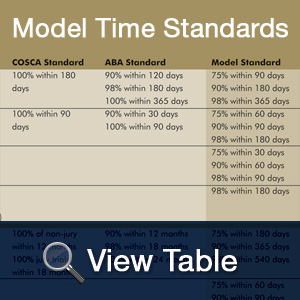 Time standards for trial courts in some form have been around since Lyndon Johnson was in the White House when the American Bar Association first adopted speedy trial standards for criminal cases. But a recent report has put them in the spotlight again.
Time standards for trial courts in some form have been around since Lyndon Johnson was in the White House when the American Bar Association first adopted speedy trial standards for criminal cases. But a recent report has put them in the spotlight again.
In August 2011, the Conference of Chief Justices, the Conference of State Court Administrators, the American Bar Association House of Delegates, and the National Association for Court Management approved a set of Model Time Standards for State Trial Courts. The standards are the product of a two-year review by the above organizations with the help of the National Center for State Courts, and support from a grant from the State Justice Institute.
Since the ABA first adopted time standards in 1968, it adopted time standards for other types of cases in 1976, updated them in 1984 and again in 1992. The Conference of State Court Administrators first established national time standards for state court cases in 1983.
Time standards are intended to establish parameters for the time required to dispose of cases from the date of filing to the date of disposition by entry of judgment. The model standards provide for a first tier time period within which 75 percent of the filed cases should be resolved; a second tier time period within which 90 percent of the filed cases should be resolved; and a third tier time period within which 98 percent of filed cases should be resolved. The 98 percent tier is meant to establish a backlog measure and to fix the maximum time that should be taken to decide and finalize all but the most highly complex cases.
The model time standards cover the full range of cases that are heard and decided by state trial courts, including all types of criminal, civil, family, juvenile and probate matters. Under the model standards, using criminal felonies as an example, 75% should be decided within 90 days; 90% within 180 days; and 98% within 365 days. The model standards are intended to establish a reasonable set of expectations for the courts, for lawyers, and for the general public. Model standards in criminal cases are also provided for misdemeanor, traffic and local ordinance, and habeas corpus and post-conviction proceedings.
The National Center for State Courts has published the standards, and the document can be found at: http://tinyurl.com/modeltime
The new publication recognizes it is important for court leaders to create circumstances that will promote a high likelihood of success once time standards are adopted. It discusses in detail the adoption and use of model time standards, the measurement of court compliance with time standards, steps to promote compliance with the standards, and the relationship between time standards and court resources.
Over three quarters of the states have now adopted some case disposition time standards. Such standards set court performance goals, which courts then can measure through the CourTools performance measurement system developed by the National Center for State Courts. The CourTools system provides ways to evaluate ten different performance measures, among them being (1) time to disposition, (2) age of active pending caseload, (3) clearance rates for cases and (4) cost effective case processing. Many state court systems use a combination of weighted caseload measures, time standards and the CourTools performance measures to assess judicial resources and performance. Although Indiana has not adopted time standards for case disposition, a number of Indiana county court systems are working to implement some of the key CourTools performance measures within their jurisdictions.